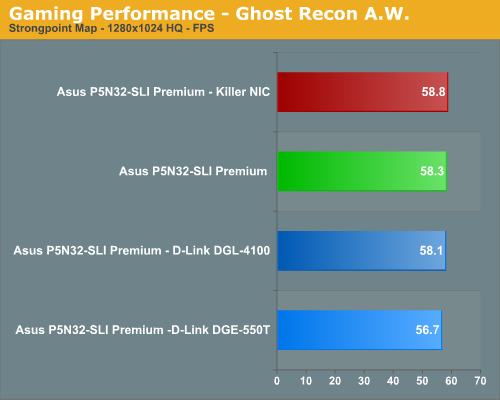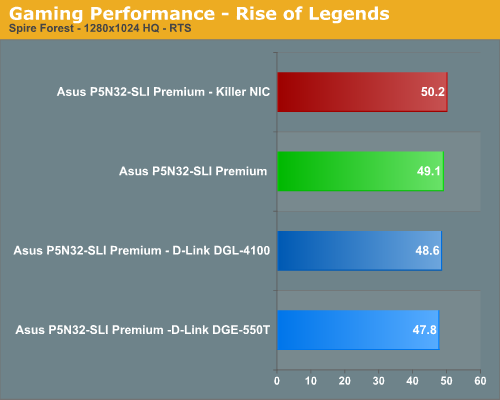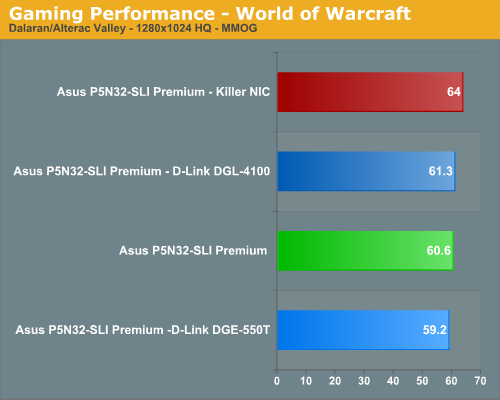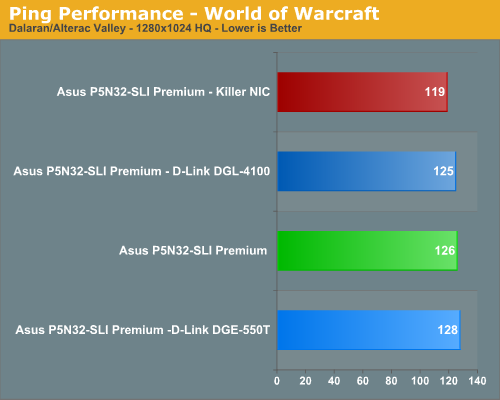BigFoot Networks Killer NIC: Killer Marketing or Killer Product?
by Gary Key on October 31, 2006 2:00 AM EST- Posted in
- Networking
Ghost Recon: Advanced Warfighter
While not the most popular online shooter this game has picked up steam lately with the 1.3 patch. We are playing on the Strongpoint map with a total of 12 players. Our video resolution is at 1280x1024 HQ and we found this game to be very playable at frame rates above 40 fps. The servers we connected with were generally showing ping rates around 45ms to 60ms at the time of connection.

We see a very slight frame rate improvement in this game but nothing that was noticeable during game play. It was difficult to tell any differences in game play between each product and as far as we could tell all systems played the game in a similar manner. If we had to make a choice we would choose the NVIDIA nForce 590SLI NIC as it seemed a tad bit smoother in certain areas.
Company of Heroes
Company of Heroes is one of our favorite RTS games around the office. We are playing the Lorraine map in one versus one player mode. Our other test party hosted the game and we found their system configuration to be nearly identical to ours. Our resolution was set to 1280x1024 with all options on high except for AA. This game is very playable with frame rates above 35 fps in multiplayer action.

Bigfoot Networks stated to us early on not to expect any measureable performance differences in the majority of RTS games. Sure enough we did not see any improvements although the Killer NIC did score a little higher than our D-Link solutions. Once again, we did not notice any real differences in game play between any of the products. We actually tried the Killer NIC in APP mode and were greeted with basically the same level of performance.
Rise of Legends
This game was released a few months back and like most real time strategy games is very CPU intensive but still offers a very visual experience. In order to experience the game properly you need a fast CPU, very good memory subsystem, and a decent GPU to play at the higher resolutions. This is one game that seems to have the perfect recipe for the Killer NIC. We are playing the Spire Forest map with Vinci versus Vinci. We generally found the game to be enjoyable with an average frame rate above 40 fps.

Although BigFoot Networks had stated most RTS games will not show any improvements we see a slight increase in frame rates with this game. We have to temper our results with the fact that there was not any noticeable difference in game play between the various products once again. In a blind performance test, any setup could have won for the most enjoyable game play experience.
World of WarCraft
WoW is the largest and probably most enjoyable MMO we have played and is a favorite amongst many of our staff members. This is another title that BigFoot Networks has explicitly stated will show performance improvements and is one that is mentioned in most of their marketing materials. We logged in at several different times that range from Wednesday morning to late night Saturdays to ensure we experienced a wide variety and number of players on the server. We started in the Dalaran Ruins and traveled to the Alterac Valley battlegrounds doing our best to battle the same creatures with each character.


We see about a 4% increase over our other products in frame rates. WoW is basically capped at 64 fps with dual core systems so it is difficult to determine if the Killer NIC would provide any further frame rate increases with our test platform. We have seen increases quoted in the 10% or plus range in this game so we utilized a 3.4GHz P4 in our test bed and noted a 9% increase in frame rates. The Killer NIC gets a point for increasing frame rates as advertised. Of course anything over 35 fps in this game is very playable so the increases while nice did not really improve our game play.
Ping rates did improve by up to 7% (host system improvements and server variables) and this is where we did notice a difference in game play during the busy test sessions on Friday and Saturday nights. When our area was full of players we did notice smoother game play at times with the Killer NIC. This did not happen when we were basically the only characters playing in certain sections. This game is designed to a certain degree for higher ping rates so there is some balancing that is already done by the server during combat. Overall, the Killer NIC performed almost as advertised in this benchmark.
In order to make sure we were not drinking the Snake Oil we did a blind performance test in WoW with a third party. The third party had no idea their on-board NIC had been replaced with the Killer NIC. The first reaction was a question asking if an additional one gigabyte of RAM had been added to the system or if the video card had been changed. This would normally make for very good publicity and we found it slightly amazing that someone would pick up on the differences in performance so quickly. However, this configuration was a dual core CPU based mid-range system and the user would not be one to spend $279.99 on a peripheral other than a new graphics card. If someone had offered them this card for $50 in order to improve their WoW experience they probably would have jumped at it instead of gasping when told the actual price.
While not the most popular online shooter this game has picked up steam lately with the 1.3 patch. We are playing on the Strongpoint map with a total of 12 players. Our video resolution is at 1280x1024 HQ and we found this game to be very playable at frame rates above 40 fps. The servers we connected with were generally showing ping rates around 45ms to 60ms at the time of connection.

We see a very slight frame rate improvement in this game but nothing that was noticeable during game play. It was difficult to tell any differences in game play between each product and as far as we could tell all systems played the game in a similar manner. If we had to make a choice we would choose the NVIDIA nForce 590SLI NIC as it seemed a tad bit smoother in certain areas.
Company of Heroes
Company of Heroes is one of our favorite RTS games around the office. We are playing the Lorraine map in one versus one player mode. Our other test party hosted the game and we found their system configuration to be nearly identical to ours. Our resolution was set to 1280x1024 with all options on high except for AA. This game is very playable with frame rates above 35 fps in multiplayer action.

Bigfoot Networks stated to us early on not to expect any measureable performance differences in the majority of RTS games. Sure enough we did not see any improvements although the Killer NIC did score a little higher than our D-Link solutions. Once again, we did not notice any real differences in game play between any of the products. We actually tried the Killer NIC in APP mode and were greeted with basically the same level of performance.
Rise of Legends
This game was released a few months back and like most real time strategy games is very CPU intensive but still offers a very visual experience. In order to experience the game properly you need a fast CPU, very good memory subsystem, and a decent GPU to play at the higher resolutions. This is one game that seems to have the perfect recipe for the Killer NIC. We are playing the Spire Forest map with Vinci versus Vinci. We generally found the game to be enjoyable with an average frame rate above 40 fps.

Although BigFoot Networks had stated most RTS games will not show any improvements we see a slight increase in frame rates with this game. We have to temper our results with the fact that there was not any noticeable difference in game play between the various products once again. In a blind performance test, any setup could have won for the most enjoyable game play experience.
World of WarCraft
WoW is the largest and probably most enjoyable MMO we have played and is a favorite amongst many of our staff members. This is another title that BigFoot Networks has explicitly stated will show performance improvements and is one that is mentioned in most of their marketing materials. We logged in at several different times that range from Wednesday morning to late night Saturdays to ensure we experienced a wide variety and number of players on the server. We started in the Dalaran Ruins and traveled to the Alterac Valley battlegrounds doing our best to battle the same creatures with each character.


We see about a 4% increase over our other products in frame rates. WoW is basically capped at 64 fps with dual core systems so it is difficult to determine if the Killer NIC would provide any further frame rate increases with our test platform. We have seen increases quoted in the 10% or plus range in this game so we utilized a 3.4GHz P4 in our test bed and noted a 9% increase in frame rates. The Killer NIC gets a point for increasing frame rates as advertised. Of course anything over 35 fps in this game is very playable so the increases while nice did not really improve our game play.
Ping rates did improve by up to 7% (host system improvements and server variables) and this is where we did notice a difference in game play during the busy test sessions on Friday and Saturday nights. When our area was full of players we did notice smoother game play at times with the Killer NIC. This did not happen when we were basically the only characters playing in certain sections. This game is designed to a certain degree for higher ping rates so there is some balancing that is already done by the server during combat. Overall, the Killer NIC performed almost as advertised in this benchmark.
In order to make sure we were not drinking the Snake Oil we did a blind performance test in WoW with a third party. The third party had no idea their on-board NIC had been replaced with the Killer NIC. The first reaction was a question asking if an additional one gigabyte of RAM had been added to the system or if the video card had been changed. This would normally make for very good publicity and we found it slightly amazing that someone would pick up on the differences in performance so quickly. However, this configuration was a dual core CPU based mid-range system and the user would not be one to spend $279.99 on a peripheral other than a new graphics card. If someone had offered them this card for $50 in order to improve their WoW experience they probably would have jumped at it instead of gasping when told the actual price.










87 Comments
View All Comments
mlau - Tuesday, October 31, 2006 - link
Correct, I haven't (I do have bills to pay and don't waste what's left on improving my laptop). To me it's absolutely not worth shelling out 500$ so that oblivion runs with 5 fps more. Reducing resolution costs nothing. With the saved money you can buy loads of beers which will make playing that game much more interesting :)The card is too expensive for what it offers, and its benefits will vanish with the
next cpu generation, no doubt. What makes the card interesting is the integrated
offload of all of linux' filtering/routing. The card is marketed to the wrong crowd.
PS: I think ati and nvidia need to be congratulated for finding another
reason for gamers to shell out money. (and look, ati also wants you to buy 3 cards in the
near future, for another completely useless thing: physics "simulation". I bet hundreds
of people can't wait to post benchmarks and how it improved their framerates and how
"physically correct" the dust now settles in $GAME)
rushfan2006 - Wednesday, November 1, 2006 - link
Agreed. I am a gamer a very long time gamer btw...if that counts for anything to do with anything...LOL...I've always built my own gaming boxes throughout the years -- so I think I have some relevant experience to base my opinions on. Though the guy is a bit brutish in how he makes his remarks, factually I believe he's correct in that right now with the state of technology the price:performance ratio for dual cards in games is just not there. If I'm going to invest a total of $1000 (two cards) I'd want to see DRAMATIC improvements. Now we all have our own standards -- so let me define mine...even 10% performance game for that investment is NOT "dramatic" to me. Research the benchmarks from your favorite tech sites, don't take my word for it -- the benchmarks speak for it.As for the topic of this Killer NIC...for me personally, as a gamer, its just a waste of money and the concept of it kind of makes me laugh to be honest.
imaheadcase - Tuesday, October 31, 2006 - link
I agree, crossfire/SLI is not all that at all. Its just a marketing tool to make gamers think they need it. The difference though is that it has some nice uses other than games.Games should be the LAST thing people should think about when getting SLI/Crossfire.
Frumious1 - Tuesday, October 31, 2006 - link
I'm not sure if you're being sarcastic or idiotic. Hopefully the former? Marketing tools are trying to peddle something that has a negligible impact. You know, convincing people to upgrade from a 2.4 GHz E6600 to a 2.93 GHz X6800 for three times the cost... maximum performance increase is 22% for a 200% price hike! CrossFire and SLI on the other hand can give up to a 90% (and usually at least 50%) performance increase for a 100% price increase.Yup, that's totally marketing. So are large LCDs, because those are completely useless. (Yes, that's sarcasm.)
feelingshorter - Tuesday, October 31, 2006 - link
How about spend 300 bucks and buy windows? My bit defender works just fine as a firewall and doesn't use 300 dollars worth of CPU. Hell, you can buy a new cpu and off set any performance hit using software firewall with 300 bucks!Hypernova - Tuesday, October 31, 2006 - link
But as the review says currently there are still NOTHING that shows the potential of FNapps. This is the card 2nd biggest selling point yet there's still nothing to show for it.cosmotic - Tuesday, October 31, 2006 - link
I don't think the "per second" is appropriate.